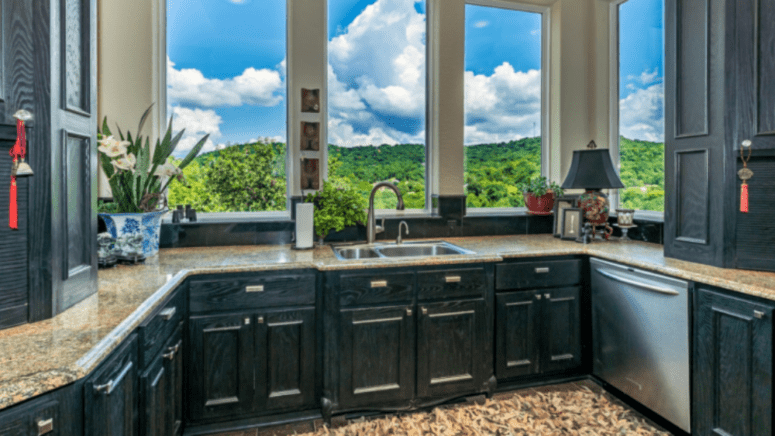Should You Flip a House in 2025? Steps, Costs, and Cautions
- Published on
- 10 min read
-
 Dena Landon, Contributing AuthorClose
Dena Landon, Contributing AuthorClose Dena Landon Contributing Author
Dena Landon Contributing AuthorDena Landon is a writer with over 10 years of experience and has had bylines appear in The Washington Post, Salon, Good Housekeeping and more. A homeowner and real estate investor herself, Dena's bought and sold four homes, worked in property management for other investors, and has written over 200 articles on real estate.
-
 Richard Haddad, Executive EditorClose
Richard Haddad, Executive EditorClose Richard Haddad Executive Editor
Richard Haddad Executive EditorRichard Haddad is the executive editor of HomeLight.com. He works with an experienced content team that oversees the company’s blog featuring in-depth articles about the home buying and selling process, homeownership news, home care and design tips, and related real estate trends. Previously, he served as an editor and content producer for World Company, Gannett, and Western News & Info, where he also served as news director and director of internet operations.
Home improvement shows have popularized the concept of “flipping” houses, bringing this segment of the real estate industry into the living rooms of everyday Americans, even inspiring some to take on the challenge of buying a home needing TLC, updating the home with old-fashioned sweat equity, and selling for a nice profit.
According to real estate data firm ATTOM, flip transactions currently represent 7.5% of all single-family home and condominium sales, or one of every 13 home sales. Their latest report indicates that while the percentage of flipping activity decreased, it continued to see increased margins, with the typical profit margin up from the first to the second quarter of 2024 in 50% of the metro areas analyzed. They were also up annually in almost 58% of the same markets.
Sebastian Frey is a top real estate agent in Santa Cruz, California, with 21 years of experience working with house flippers to help them locate properties. While he thinks that it’s harder today for flippers to find good properties than in the past, he says, “There’s always a demand for rehabbed properties. If they’re done meticulously, there will be a lot of demand for that. People are happy to pay top dollar for a quality remodel in a good location.”
If you’re thinking about flipping a home in 2025, is it still a good idea?
What is house flipping?
House flippers buy homes, hold them for a couple of months, and then sell them for a profit (that’s the flip part). Typically, they buy distressed properties — either short sales, foreclosures, or homes that need significant work — fix them up, and sell them for a hefty return on their investment. Sometimes flippers buy and sell homes to wholesalers without making any repairs or updates.
The goal is to buy low and sell for a high profit — one that covers both the home’s initial cost and any improvements.
Is flipping a house a good investment in 2025?
While the return on investment (ROI) has been seeing slight recovery in recent years following a six-year decline, profits have fluctuated due to unstable home prices since the pandemic. The first two quarters of 2024 witnessed a slight improvement in both average gross profit and ROI, attributed to a faster rise in median resale prices of flipped homes.
Based on available 2024 data, the gross profit on typical flip transactions is currently 30.4%, which translates to about $73,500. Gross profits are calculated from the difference between the median purchase price paid by investors and the median resale price.
Higher home prices reduce flip opportunities
In the third quarter of 2024, the National Association of Realtors (NAR) reported that 81 out of 180 metropolitan areas saw their home prices more than double in a decade. Nationwide, median home prices rose to $418,700. When home prices rise, it’s harder for flippers to find good deals that will net a profit.
There’s also more competition in the market for homes to flip — homes that need just the right amount of work, and are priced well, are in high demand among investors. Rising mortgage rates are also partially to blame for limited inventory, as potential sellers are hesitant to trade their current low mortgage rate for a rate in the 6%-7% range.
In addition, flippers who rely on hard money financing to both acquire and flip homes could struggle to compete against investors with cash due to the amount of time it takes for a lender to close on a loan.
Even though home prices have risen, the market has cooled. “The market isn’t rocketing up like it was, and flippers need to be much more judicious about what they’ll pay for a property,” Frey cautions. New flippers, especially, could end up over their heads if something goes wrong and they can’t sell within their expected timeframe.
And a lot can go wrong.
What can go wrong with a house flip in 2025?
A beginner in the field of house flipping may fall prey to the common mistakes when doing a house flip. These common mistakes include not having a buffer for renovation costs, and not accounting for the time it takes to flip a house. However, there are also mistakes that are hard to watch out for.
Experienced flippers price out home repairs before purchasing a house, and leave themselves a cushion for the unexpected. But not even they could have predicted the 20% increase in construction materials between January 2021 and 2022. Fortunately, material cost increases for residential construction have started to stabilize in 2024.
Increases in construction costs could eat away at your flip’s profit, or put you in the red. A delay in getting permits, or having materials delivered, would also decrease profits due to increased holding costs. The longer you own the house before flipping it, the tighter the profit margin.
According to Frey, a lot of flippers don’t really add up the holding costs of home insurance, interest rates on short-term money, high property taxes, and transfer fees. After the property acquisition costs, flippers have “six months of flip costs on top of that — people don’t understand how long it could take to do a flip,” warns Frey.
When you put together your budget for a flip, don’t forget to add in all these costs. And leave yourself a cushion — or, extra money between your costs and your profit — for unexpected cost increases.
How much does it cost to flip a house in 2025?
National average: Based on estimates from pricing websites like HomeAdvisor and Angi, the cost to flip a house can range between $19,498 to $88,421, with the average flip costing about $52,500. Costs vary based on what the home needs and what you plan on updating, the area you live in, labor costs for contractors and landscapers, and more.
Target spend goal: A profit-focused target goal among many investors is to spend around 10% of a home’s purchase price to flip the property. For example, if you buy a home for $180,000 and plan to flip it for $360,000, your initial optimistic cost estimate might be to only invest $18,000 to accomplish the flip.
The reality rule: However, when comparing the national average with the target spend goal, another common investor rule to consider is that “It always takes longer and costs more than you think it will.”
Don’t forget to include the following costs in your budget:
- Down payment and lender fees
- Home inspection fees
- Closing costs
- Mortgage payment, property taxes, and insurance fees for every month you’ll own the property
- Contractor fees
- Permit fees
- Utilities while you own
- Marketing fees, such as a stager and professional photographer
- Real estate agent fees to sell the property
Working with a real agent, somebody who has a really good flow of sellers who might sell to a flipper, is very valuable to a flipper.
 Sebastian Frey Real Estate AgentClose
Sebastian Frey Real Estate AgentClose Sebastian Frey Real Estate Agent at Compass Currently accepting new clients
Sebastian Frey Real Estate Agent at Compass Currently accepting new clients
- Years of Experience 22
- Transactions 318
- Average Price Point $621k
- Single Family Homes 252
Step by step house flipping process
Ready to try flipping? Follow these steps for success.
1. Create your network and evaluate your skills
Unless you’re a licensed contractor, you’ll need a network of professionals to help you flip. Even if you’re handy around the house, evaluate your skills honestly. For some projects, particularly electrical and plumbing, you’ll need an expert.
Keep in mind that buyers may be wary of purchasing a flipped home if they can’t verify that permits were pulled and the work was done by licensed professionals.
Put together a network of experienced, licensed professionals before you start scouting houses. In addition to people to perform the remodeling work, you’ll need an agent to find homes, a stager to help sell them, and possibly a lawyer to draw up legal documents.
2. Develop your budget
A budget that takes into account all repairs, fees, and the unexpected is a key piece to successfully flipping a home. But, how do you account for the unexpected? Since flippers don’t have a crystal ball to see the future, the industry has developed the 70% rule.
This rule states that you should never pay more than 70% of the after-repair-value or “ARV” of a property, less any repairs, that you’re flipping. The ARV is your estimate of the home’s worth after all repairs have been done.
For example, if the ARV of your flip is $300,000, and it needs $50,000 in repairs, you shouldn’t pay more than $160,000 to acquire the property.
$300,000 x 0.7 = $210,000
$210,000 – $50,000 = $160,000
If all goes well and you sell the house for its after-repair value of $300,000, you’d still have $90,000 in profit to cover other expenses (such as agent and stager fees). Even if something went wrong, you likely wouldn’t end up losing money.
3. Research your market
How many days are homes spending on the market? Are they selling for over or under list price? What about demand — are sellers receiving multiple offers on their homes?
Research the local market before deciding to purchase and flip a home in that area. The longer it takes to sell a completed flip, the higher your costs rise. Current and predicted home price trends can have a big impact on your potential profit.
An experienced, local agent can be an invaluable resource. Frey says that a local agent can help flippers “figure out current market value, give them an idea of some of the features you might want to do in today’s market, and estimate the sale price for the rehab projects.”
4. Partner with a real estate agent
A real estate agent helps with identifying current trends and popular home upgrades. When it’s time to sell your flip, they’ll sell and market it. But they can also help you find houses to flip.
Due to low inventory, it’s become harder for flippers to identify potential homes. “Working with a real agent — somebody who has a really good flow of sellers who might sell to a flipper — is very valuable to a flipper,” Frey points out.
5. Find a home to flip
Once you’ve got an agent keeping an eye out for you, alerts set up on real estate websites, and they’re scouring the multiple listing service, it’s time to find a home to flip. It could take several months, and you might have to make several offers on available homes before you’re successful. Be patient!
Once you win your bid, it’s absolutely crucial that you get a home inspection and an appraisal. When you walked through the home, you could probably tell you’d need to remodel the bathroom to sell. But a home inspection will reveal any hidden issues beneath the surface, such as a rotted subfloor in that bathroom, which you might have to replace to safely and successfully flip the home.
An appraisal is an estimate of the home’s current market value. If you’re using hard money or a mortgage to finance the flip, the lender will likely require it. The appraisal tells you what the home is worth now — which is valuable information if you’re concerned that you’re paying too much.
6. Renovate the home
Line up the contractors, plumbers, electricians, and anyone else you might need to begin work the day after the closing. Check licenses and references before signing any contracts. Once the property is yours, there’s no time to waste!
According to HomeLight’s Top Agent Insights for End of Year 2024, 94% of surveyed agents say that a modernized bathroom or kitchen is an excellent upgrade to make a property more appealing to buyers in the current market. A kitchen remodel is estimated to add an average of $28,826 in value, while a fresh coat of paint can add an average of $10,184. Meanwhile, decluttering could generate an additional $11,706.
All of these projects have the added benefit of improving the home’s appearance and potential appeal to buyers. Remember that whatever you can do yourself — whether it’s a fresh coat of paint or scraping popcorn from the ceiling — builds sweat equity that will make you money when you sell.
7. Rent or sell the property
Once the work is done, flippers have a choice. You can either rent the home and become a landlord, or sell it. If you used hard money to finance your purchase, you’ll have to refinance to hold the property long-term and rent.
Should you flip a house in 2025?
Only you can answer this question based on your finances, experience, and market knowledge. Markets vary widely by geographic area, as does the cost to flip a home.
Frey’s best advice is to buy low. “The market has shifted, so my advice would be don’t take on any big projects unless you get them at a seriously discounted price,” he says. When you flip a house, your goal should be to get out of the project quickly with the best return on your investment.
HomeLight can connect you with a top agent in your market with proven experience in locating homes suitable for a house flip investment.
Header Image Source: (Mary Ann Wooten / Unsplash)




